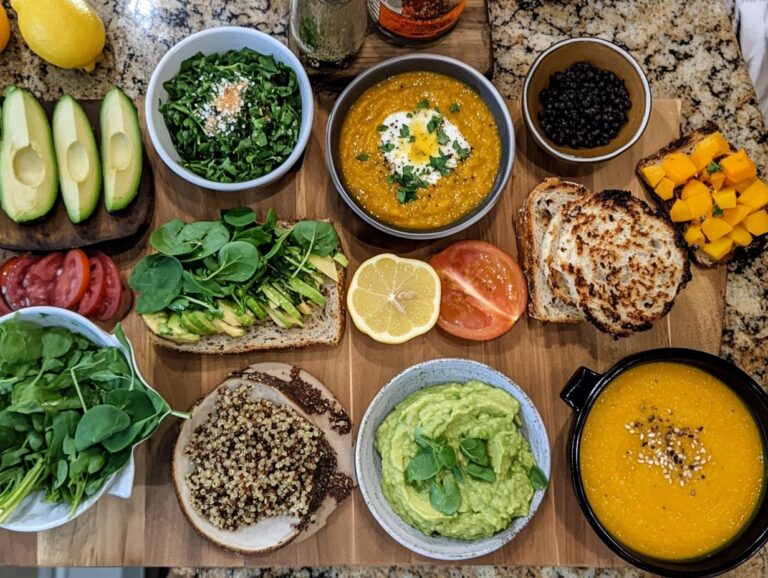Filipino cuisine is known for its rich flavors and vibrant ingredients, although traditional recipes often rely on meat and dairy. This guide explores various ways to enjoy the delicious essence of Filipino cooking while maintaining a plant-based lifestyle. It highlights the health and environmental benefits of vegan Filipino dishes and features must-try recipes such as Adobo Tofu and Pancit Bihon. Additionally, the guide offers tips on how to substitute traditional ingredients and enhance flavors using fresh herbs and spices.
Overview of Traditional Ingredients and Cooking Techniques
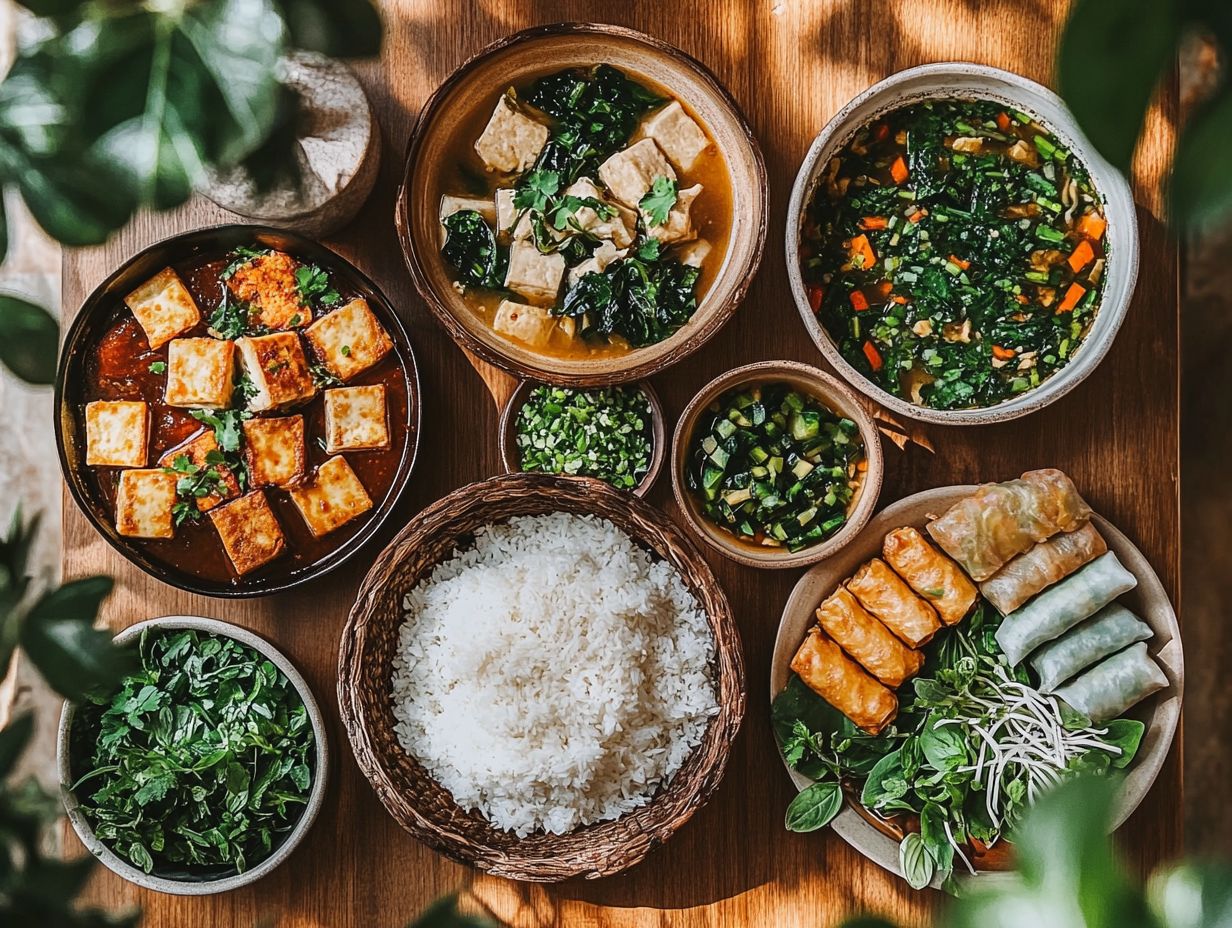 Traditional Filipino ingredients and cooking techniques are essential for creating authentic and delicious vegan Filipino recipes that capture the essence of the islands.
Traditional Filipino ingredients and cooking techniques are essential for creating authentic and delicious vegan Filipino recipes that capture the essence of the islands.
- Rice: As the most important staple in the Philippines, rice is served with nearly every meal. Its high carbohydrate content and versatility make it a crucial component of Filipino vegan recipes, able to accompany a wide array of vegetable-based and protein-based dishes.
- Soy Sauce: Soy sauce is a fundamental ingredient in Filipino kitchens, commonly used in marinades and as a flavor enhancer for vegetable and protein dishes. Its salty flavor elevates the taste of the ingredients and enhances the umami profile of the meal.
- Vinegar: Vinegar is one of the most versatile and widely used ingredients in traditional Filipino cooking. It frequently appears in sauces, salad dressings, and marinades. The sour notes of vinegar are particularly pronounced in adobo, a well-known Filipino dish that typically features chicken or pork and is served with vinegar and soy sauce.
- Stir-Frying: Stir-frying, which involves saut ing vegetables in oil with garlic, onion, and/or ginger, is a common cooking method in the Philippines. This technique typically takes place in an open pan over high heat, creating an aromatic base that allows for the development of more complex flavors through the addition of ingredients like coconut milk, soy sauce, or vinegar.
- Simmering: Simmering is another popular cooking method in the Philippines. After saut ing meat, vegetables, or fish in oil, water or broth is added and brought to a boil before being reduced to a simmer, ensuring that all ingredients cook evenly. This method is often used to create stews, soups, and thick sauces.
- Grilling: Grilling and barbecuing are among the most beloved traditional cooking techniques in the Philippines. Marinated grilled eggplant or jackfruit skewers are a great way to incorporate this traditional method into modern culinary practices.
Benefits of Vegan Filipino Recipes
Vegan Filipino recipes offer numerous benefits, including health and environmental advantages, making them beneficial for both individuals and society. Transitioning to plant-based alternatives can enhance overall health, aid in weight loss, and lower the risk of chronic diseases, all while allowing people to enjoy the familiar flavors of Filipino comfort food. Embracing veganism also helps reduce carbon emissions and fosters a more sustainable food system, which is increasingly important in today’s world.
Health and Environmental Advantages
The health and environmental benefits of a vegan diet are numerous, particularly when exploring Filipino cuisines and recipes adapted to veganism. Choosing vegan recipes ensures a diverse array of nutrients, vitamins, and minerals that benefit the human body while also decreasing environmental impact. Research from the American Heart Association and other sources indicates that plant-based diets can help lower blood pressure, reduce the risk of heart disease, and improve overall health outcomes. Adopting a vegan diet not only reduces one’s carbon footprint but also lessens reliance on animal agriculture. This shift benefits personal health and contributes to the fight against climate change by reducing greenhouse gas emissions from the livestock sector. When discussing popular Filipino dishes such as adobo, sinigang, and kare-kare, plant-based substitutes for meat, dairy, and eggs can be utilized to preserve traditional flavors and cooking methods while promoting sustainable farming practices. Ingredients like jackfruit, tofu, various legumes, and other alternatives can effectively replace meat and dairy in these dishes, leading to improved nutrient intake and greater dietary diversity.
Must-Try Vegan Filipino Dishes
Here are some of the most popular vegan Filipino dishes, including twists on comforting meals and creative vegan recipes:
- Tofu Adobo: This beloved dish highlights the famous adobo cooking style of the Philippines, which involves marinating and braising food in vinegar, soy sauce, and spices.
- Tofu Sisig: A vegan twist on the traditional Filipino dish called sisig, which is typically made with chopped pork.
- Arroz Valenciana: A traditional Filipino rice dish often served during special occasions and celebrations. Similar to paella, it is made with glutinous rice, coconut milk, vegetables, and spices.
- Lumpiang Shanghai (Vegan Spring Rolls): These crispy and flavorful rolls are filled with a variety of vegetables and sometimes tofu, making them a popular vegan snack or appetizer. They highlight the innovative use of vegan meat alternatives in Filipino cuisine.
- Filipino-style Macaroni Soup: Known as “sopas” in Filipino, this creamy and comforting dish is often made with chicken, but it can easily be adapted to be vegan by using vegetable broth and plant-based milk. This adaptation showcases the versatility of vegan Filipino recipes and their ability to transform traditional comfort foods into healthy plant-based alternatives.
- Sinigang: A sour and savory soup that is typically made with meat and vegetables. However, it can be easily modified to be vegan by using vegetable broth and a variety of fresh vegetables.
- Pinakbet: This traditional vegetable stew features a variety of local vegetables, such as eggplant, bitter melon, and okra, and is often flavored with shrimp paste. It wonderfully showcases how plant-based ingredients can create umami-packed flavors reminiscent of traditional Filipino dishes.
- Vegan Pancit (Noodles): A popular noodle dish that is typically made with meat and seafood but can easily be adapted to be vegan by using various vegetables and plant-based protein sources. This dish emphasizes the comfort of Filipino cuisine while incorporating healthy plant-based elements.
- Ginisang Sayote (Saut ed Chayote): A simple yet flavorful dish featuring saut ed chayote (a type of squash) with garlic, onion, and tomato. It can easily be made vegan by omitting any meat or seafood ingredients.
These vegan Filipino dishes not only showcase the rich and diverse flavors of Filipino cuisine but also offer a delicious and healthy way to enjoy plant-based meals.
Adobo Tofu
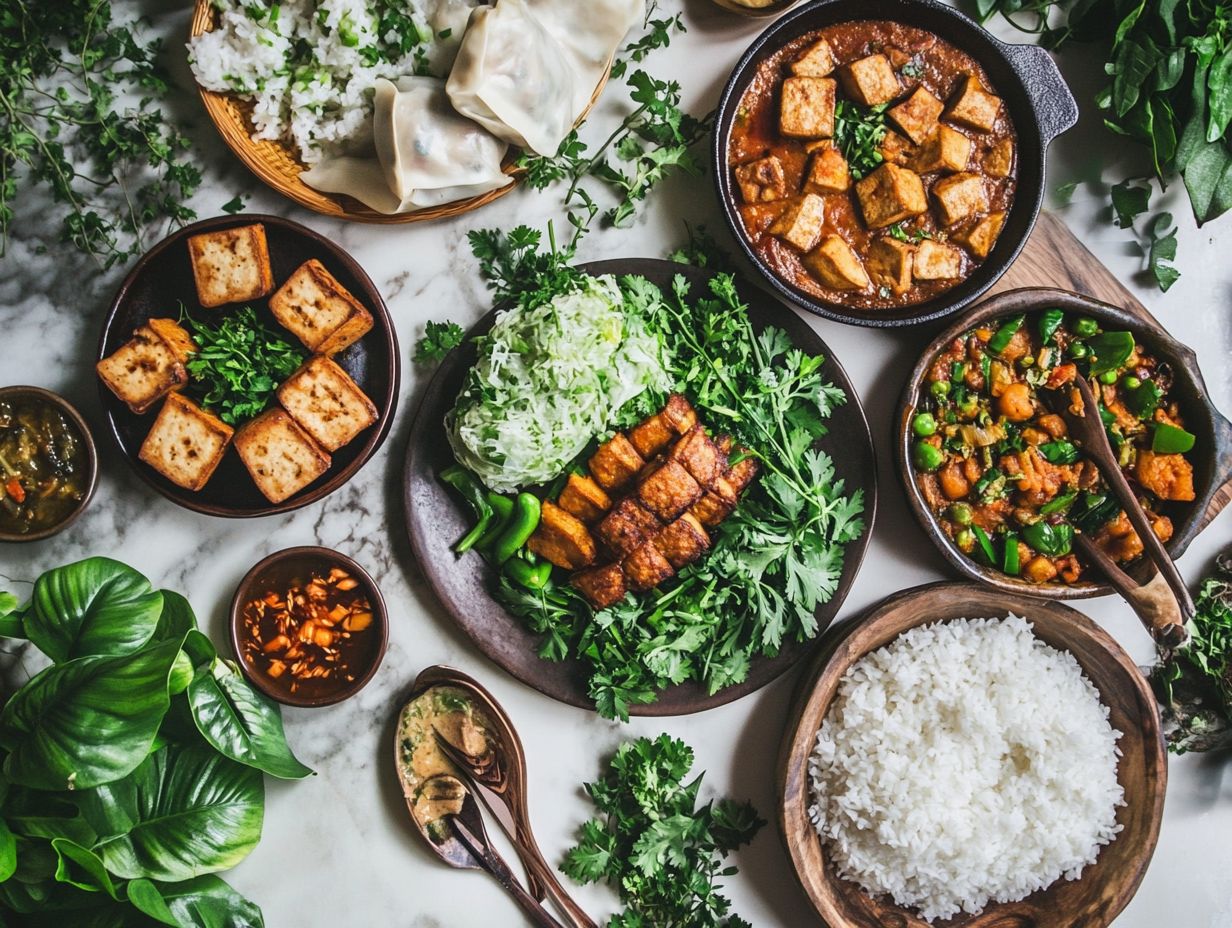 Adobo tofu is a savory and richly flavored vegan alternative to the traditional Filipino dish known as savory tofu adobo. This dish features marinated tofu stewed in soy sauce, vinegar, garlic, and peppercorns, and it can be served as a main course or alongside rice. It illustrates how plant-based alternatives can effectively replace traditional proteins in comfort food recipes. To prepare adobo tofu, firm tofu, which absorbs marinade well, is typically used. The tofu must first be pressed to remove excess moisture, allowing it to better absorb the flavors of the marinade. After pressing, the tofu is cut into cubes and marinated in soy sauce, cane vinegar (the Philippines’ national condiment), minced garlic, and freshly ground peppercorns for at least 30 minutes. This marinating process is crucial for achieving authentic adobo, as it allows the tofu to soak up the rich, savory flavors of the marinade. Next, the tofu is saut ed until golden brown, after which the remaining marinade is added and simmered until the sauce thickens. The final dish is fragrant and warm, making it perfect for family gatherings.
Adobo tofu is a savory and richly flavored vegan alternative to the traditional Filipino dish known as savory tofu adobo. This dish features marinated tofu stewed in soy sauce, vinegar, garlic, and peppercorns, and it can be served as a main course or alongside rice. It illustrates how plant-based alternatives can effectively replace traditional proteins in comfort food recipes. To prepare adobo tofu, firm tofu, which absorbs marinade well, is typically used. The tofu must first be pressed to remove excess moisture, allowing it to better absorb the flavors of the marinade. After pressing, the tofu is cut into cubes and marinated in soy sauce, cane vinegar (the Philippines’ national condiment), minced garlic, and freshly ground peppercorns for at least 30 minutes. This marinating process is crucial for achieving authentic adobo, as it allows the tofu to soak up the rich, savory flavors of the marinade. Next, the tofu is saut ed until golden brown, after which the remaining marinade is added and simmered until the sauce thickens. The final dish is fragrant and warm, making it perfect for family gatherings.
Pancit Bihon (Vegan Pancit)
Vegan Pancit Bihon is a traditional Filipino noodle dish that has been adapted to be vegan without sacrificing its characteristic flavor. This dish features rice vermicelli noodles, which are combined with a variety of saut ed vegetables. Like many other traditional Filipino noodle recipes, Pancit Bihon is often served at celebrations and gatherings, making it a popular choice for special occasions. Vegan Pancit Bihon is prepared with an assortment of vegetables and soy sauce, resulting in a comforting and mildly salty taste that is both filling and satisfying. The key ingredients for Pancit Bihon include the following:
- Bihon: These thick rice noodles must be soaked in boiling water before cooking and serve as the main component of the dish.
- Vegetables: There is no single recipe for Pancit Bihon, as different families create their own versions based on personal preferences, availability, and seasonal ingredients. Common choices include carrots, bell peppers, green beans, and cabbage. True to its vegan nature, this dish does not include meat, meat stock, or chicken for flavoring.
- The Sauce: Pancit Bihon falls under the category of Pancit, which encompasses a variety of popular Filipino noodle dishes. It is defined by the use of rice vermicelli noodles and is always stir-fried. The sauce typically consists of soy sauce, oyster sauce, and other condiments that may vary according to family traditions. For a vegan version, commercially available oyster sauce alternatives or homemade substitutes can be used. Some recipes for Vegan Pancit Bihon are made without added broth or stock, relying instead on water for moisture.
Pancit Bihon is often served during special occasions such as birthdays, holidays, and celebrations, as the long noodles symbolize long life and prosperity. This Vegan Pancit Bihon can be customized to suit individual tastes and the seasonal availability of vegetables, allowing for delightful variations. This dish is a great example of vegan Filipino recipes that offer plant-based alternatives to traditional Filipino cuisine.
Kare-Kare
Vegan Kare-Kare is a plant-based version of the traditional Filipino stew, renowned for its rich and creamy peanut sauce, which is typically made with oxtail or tripe. This vegan adaptation utilizes hearty vegetables such as eggplant and green beans, all cooked in a delicious peanut sauce, creating a comforting and satisfying dish that retains many of the original flavors of Filipino cuisine. When served with bagoong (fermented shrimp paste) or a vegan alternative, Vegan Kare-Kare is sure to delight anyone looking for a taste of Filipino comfort food. This umami-packed dish is complemented by other flavorful traditional dishes like Arroz Valenciana and Mushroom Tocino, showcasing the diversity of Filipino vegan cuisine. Vegan Kare-Kare Ingredients:
- Unsalted peanut butter
- Vegetable broth
- Eggplant
- Banana heart
- Green beans
- Bok choy
- Mixed mushrooms
- Calamansi
Kare-Kare Cooking Instructions:
- Saut garlic and onion.
- Add peanut butter and vegetable broth to create the sauce.
- Incorporate the vegetables and allow them to simmer.
Vegan Kare-Kare Benefits: The inclusion of various vegetables enhances the dish’s nutritional value and provides a different taste and texture compared to the meat-based original.
Ginataang Kalabasa and Savory Tofu Adobo
Ginataang Kalabasa is a vegan Filipino dish made with sweet calabaza (pumpkin) cooked in coconut milk. This dish showcases the distinctive flavor profile of Filipino cuisine while providing a delicious plant-based alternative. The combination of sweet calabaza and other vegetables creates a delightful contrast of flavors, making Ginataang Kalabasa both hearty and nutritious. Additionally, pairing it with Savory Tofu Adobo offers a comforting meal that replicates traditional Filipino dishes using vegan meat alternatives. In Filipino cuisine, this dish highlights the versatility of coconut milk and emphasizes the importance of using local produce in its preparation principles that align with healthy eating and sustainability. To prepare Ginataang Kalabasa, begin by peeling and cubing the sweet calabaza. Saut the cubes with garlic, onion, and ginger until they soften. Then, add coconut milk and the sweet calabaza to mellow the flavors. Allow the dish to simmer for 10 to 15 minutes, enabling the ingredients to meld together and absorb one another’s flavors. The natural sweetness of the squash is enhanced, and the dish can be spiced up with added chili peppers, if desired. Traditionally served with rice, Ginataang Kalabasa allows diners to enjoy the combination of flavors together. Like many Filipino dishes, it is a communal dish that provides comfort through its warmth and serves as a wonderful way for family and friends to gather around the table.
Tips for Preparing Flavorful Vegan Filipino Meals
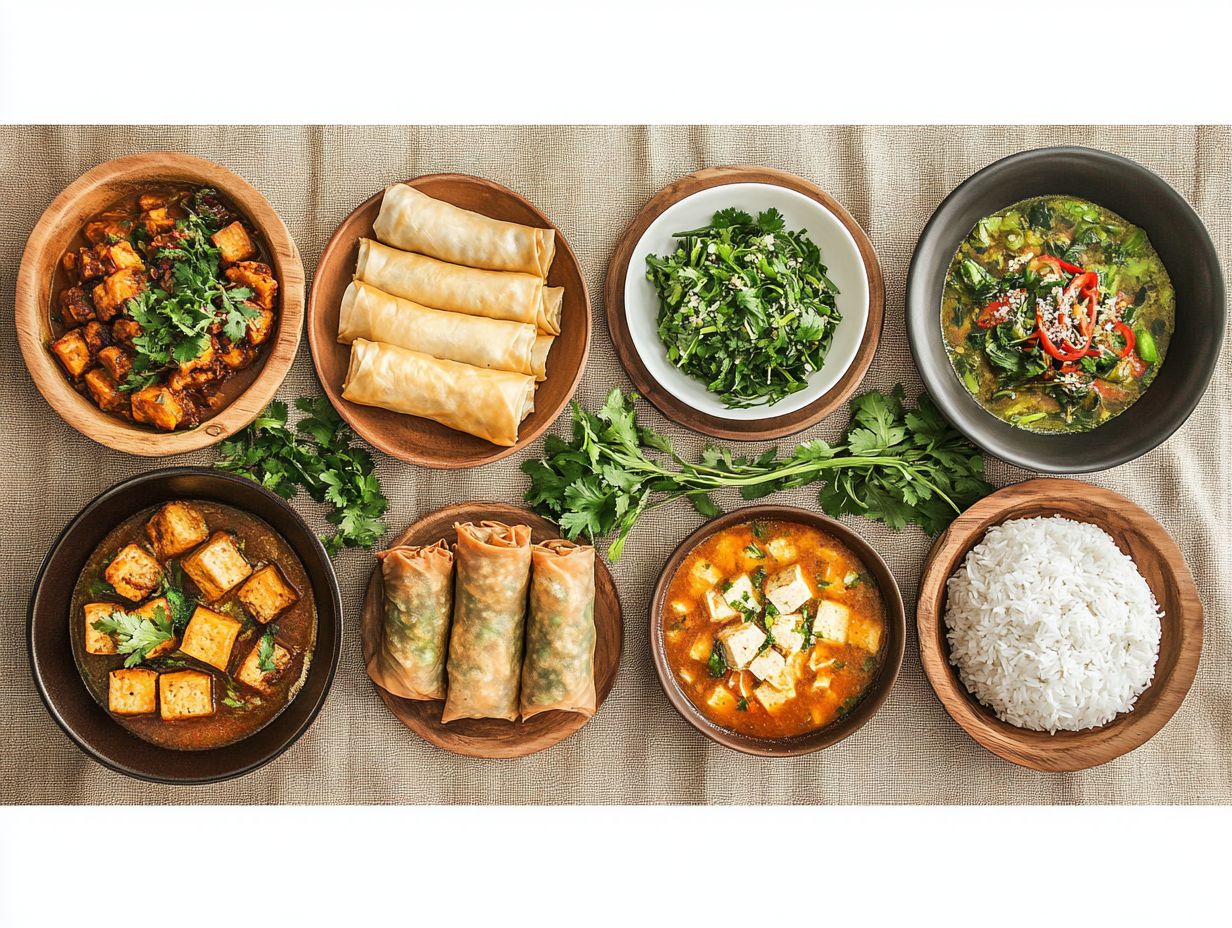 Here are some of the best tips for creating flavorful vegan Filipino meals. These suggestions will help you replicate the rich flavors and textures of traditional Filipino cuisine, allowing you to enjoy delicious plant-based versions of your favorite dishes.
Here are some of the best tips for creating flavorful vegan Filipino meals. These suggestions will help you replicate the rich flavors and textures of traditional Filipino cuisine, allowing you to enjoy delicious plant-based versions of your favorite dishes.
Use Fresh, High-Quality Ingredients in Vegan Recipes
Flavor in traditional Filipino cuisine is often built upon fresh garlic, ginger, onions, and chilies, along with high-quality vegetables and fruits. The use of fresh ingredients will significantly enhance the flavor and enjoyment of your dishes, making them as delicious as non-vegan Filipino recipes.
Adjust the Saltiness
In many Filipino dishes, soy sauce serves as the primary source of saltiness, often complemented by a sour component alongside sweetness. For those wishing to avoid soy products, alternatives like tamari, miso, or coconut aminos work well. Additionally, sea salt, vegetable broth powder, or dried seaweed are excellent gluten-free options. While vinegar can add a tangy flavor, it should be used sparingly to prevent overpowering the dish.
Add Umami
Incorporating vegan ingredients that provide umami flavors, such as mushrooms, caramelized onions, miso paste, tofu, seaweed, or nutritional yeast, can greatly enhance your dishes. This is particularly important in Filipino cuisine, where umami-rich ingredients are frequently used to build flavor. Dried aromatics, fermented ingredients, and caramelized components can contribute to umami in dishes like adobo, dinuguan, and kare-kare.
Choose the Right Substitutes
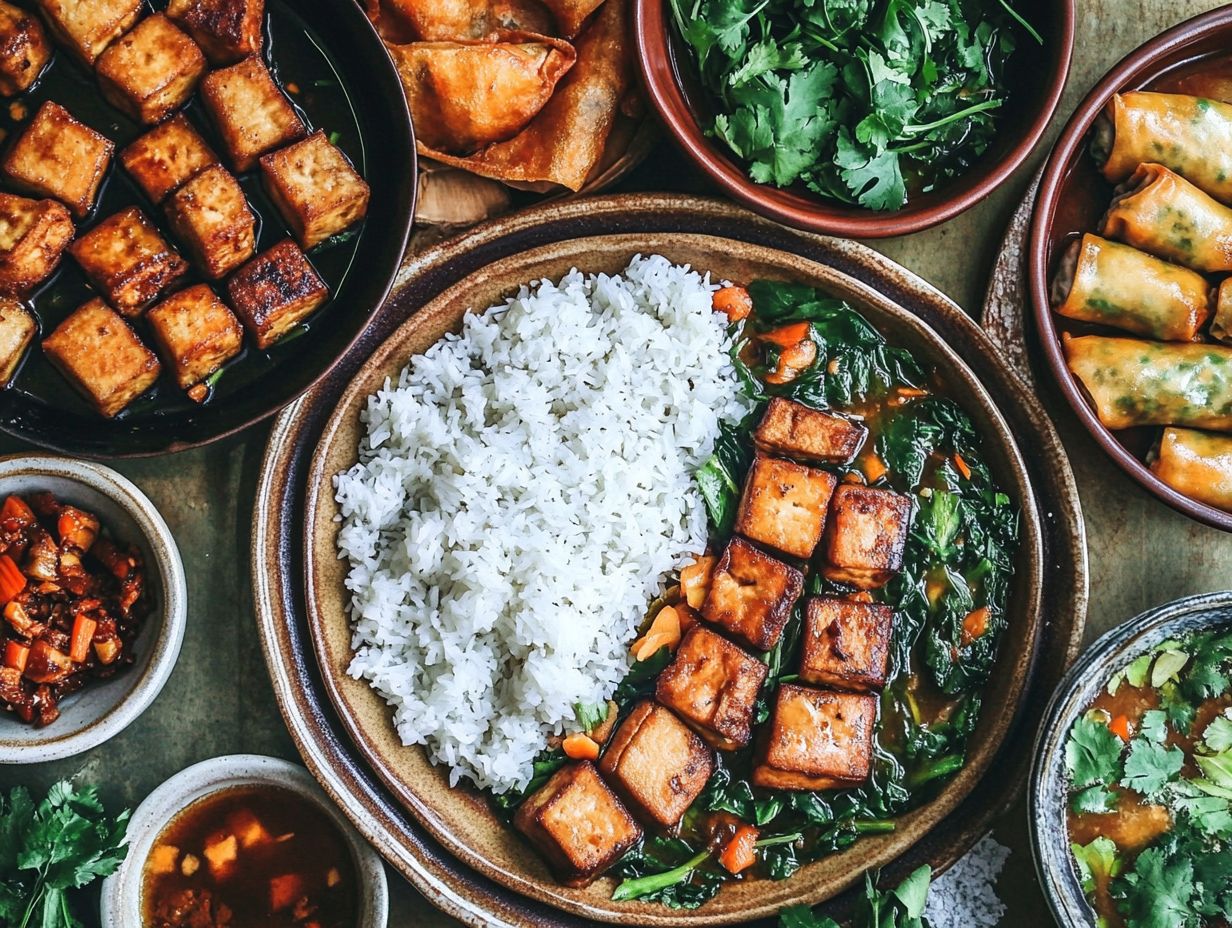 When substituting meat and dairy in traditional Filipino recipes, it’s essential to select alternatives that maintain the desired flavor and texture in vegan dishes. Tofu can serve as a meat substitute due to its protein content and texture, while coconut cream offers a creamy richness as a dairy replacement. Other substitutes worth considering include banana hearts, jackfruit, or eggplant for meat, and coconut milk, almond milk, or soy milk for dairy.
When substituting meat and dairy in traditional Filipino recipes, it’s essential to select alternatives that maintain the desired flavor and texture in vegan dishes. Tofu can serve as a meat substitute due to its protein content and texture, while coconut cream offers a creamy richness as a dairy replacement. Other substitutes worth considering include banana hearts, jackfruit, or eggplant for meat, and coconut milk, almond milk, or soy milk for dairy.
Utilize Spices and Aromatics
Garlic, ginger, and onion are crucial for building flavor in Filipino dishes. These ingredients create a base for many stews, soups, and sauces, enhancing the overall taste and aroma of the meal. For instance, saut ing garlic, ginger, and onion together before adding other ingredients forms a fragrant and flavorful foundation for dishes such as sinigang, pinakbet, and lumpia.
Substituting Traditional Ingredients with Plant-Based Options and Soy Curls
One of the best ways to create delicious vegan Filipino recipes is by replacing traditional ingredients with plant-based alternatives that retain the original flavors. Tofu and soy curls can serve as substitutes for meat in dishes like kare-kare and adobo. Jackfruit is an excellent replacement for meat in savory stews and barbecue recipes. Dairy products can easily be substituted with coconut milk, which adds a similar comforting creaminess to desserts such as leche flan and puto. Legumes like lentils and chickpeas provide protein and work well as alternatives to ground meat in lumpia and other popular dishes. Nutritional yeast can deliver the umami flavor typically achieved through the use of fish sauce or shrimp paste. Soy curls are another great option for mimicking meat textures, especially in dishes like Adobong Tokwa and Vegan Filipino Barbecue. The deliciousness of these healthy substitutes allows for the veganization of many classic Filipino dishes, promoting dietary choices while preserving the original spirit of each meal.
Enhancing Flavors with Herbs and Spices in Vegan Filipino Dishes
To authentically recreate the traditional flavors of Filipino cuisine in vegan versions, it is essential to include the same herbs and spices that enhance the taste in conventional cooking. Ingredients such as garlic, ginger, and onions serve as the aromatic base for many Filipino dishes, while herbs like cilantro and green onions add brightness and freshness. Their inclusion ensures that vegan Filipino meals achieve the same level of flavor and comfort found in traditional recipes. Vegan Filipino recipes should also incorporate spices like turmeric and black pepper, which are vital for adding warmth and complexity, similar to what is found in kare-kare and adobo. Additionally, chili peppers can provide a kick of heat for those who enjoy some spice, while bay leaves offer a subtle depth that is often desired in savory stews. One effective way to preserve these beloved flavors in vegan recipes is by preparing a plant-based sinigang using tamarind and fresh vegetables or a flavorful tofu adobo cooked in soy sauce and vinegar. Additionally, exploring dishes like Filipino spaghetti or Lumpiang Shanghai can bring a unique taste that is both nostalgic and innovative. These dishes allow the herbs and spices to shine while honoring the traditional methods of Filipino cooking.



